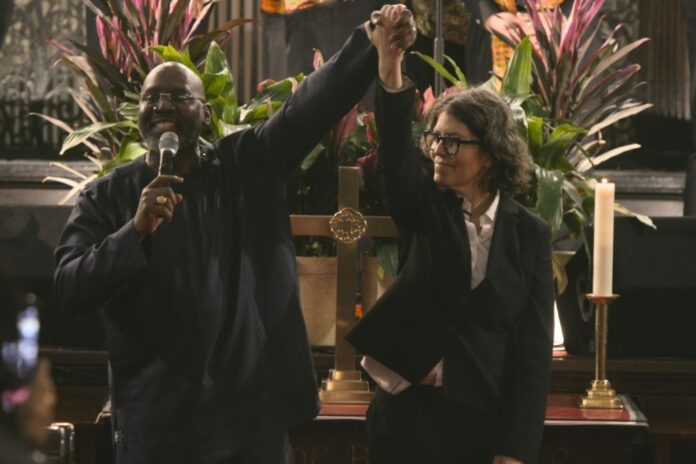Brooklyn Congregations Strive for Unity Amidst Differences in “All God’s Children”
Documentary Spotlights Unlikely Unity
Among the captivating personalities in Ondi Timoner’s 2022 documentary, “The Last Flight Home,” which explores her 92-year-old father Eli Timoner’s choice to utilize California’s end-of-life option, is the director’s sibling, Rachel. As a rabbi, Rachel Timoner infused a pastoral warmth and spiritual insight into the family’s rites, sorrows, and joys as they honored their loved one’s passing.
In “All God’s Children,” Timoner presents a sincere and unsentimental portrayal of her elder sister, Rachel. However, this documentary is not a family memoir. Rachel Timoner, the chief rabbi of Brooklyn’s historical Congregation Beth Elohim, shares the spotlight with Reverend Dr. Robert Waterman, the lead pastor of Brooklyn’s equally renowned Antioch Baptist Church, located in Brooklyn’s Bedford-Stuy neighborhood.

A Tale of Two Leaders
Despite the mere four miles between the institutions, their leaders strive to bridge the broader chasms of racism and antisemitism. “All God’s Children” chronicles the journey of this Jewish woman and this Black man as they attempt to unite their congregations in worship. Their efforts, albeit not always smooth, make this film significant and enlightening.
Leaders in the Community
The two leaders, close in age and reputation, command respect and recognition. Sen. Chuck Schumer is a regular at Beth Elohim. Rep. Hakeem Jeffries and New York Attorney General Letitia James have visited Antioch. Both leaders possess a maverick sensibility, as evidenced when the rabbi informs a class of school children that “God is beyond gender.” Their decision to embark on a journey towards greater understanding comes as no surprise. However, the events that strain their budding rapport and threaten to derail their pursuit of communal harmony are indeed surprising. As one of Antioch’s parishioners aptly puts, “Love will bring us together, but our traditions will keep us apart.” This assessment is proven accurate more than once.
Confronting Historical Challenges
The film touches upon the histories of migrations — both Black and Jewish — to Brooklyn, exploring the implications of two distinct diasporas. Familiar and still poignant photos and newsreel footage reflect the pogroms, slavery, the Holocaust, and the Red Summer that devastated Tulsa’s black community.
In 2019, the year the film begins, Black residents of Bed-Stuy fell victim to “deed theft.” This predatory practice, a tool of aggressive gentrification, allows third-party actors to seize the title of a home without the owner’s knowledge, purchase the property, and evict the real owners. Despite its name, it was not illegal in New York. Given Brooklyn’s demographics, some of the landlords and realtors partaking in this act were Jewish, while almost all the victims were Black or brown residents. This provided a compelling reason for the rabbi and the preacher to reach out.
The Journey Towards Understanding
During Antioch parishioners’ first visit to the CBE, a musical performance including the waving of flags sparked controversy. A bright yellow flag bearing the word “Jesus” set off a worried, whispered discussion between Rabbi Timoner and her second, Stephanie Kolin: Should they intervene? When Timoner later addresses the issue at a joint gathering of both congregations, the response is somewhat rocky.
Despite these challenges, the congregations persevere. They embark on a shared field trip to D.C.’s National Museum of African American History and Culture and the United States Holocaust Memorial Museum. While there is a shared recognition of the traumas rooted in their histories, the discomfort and suspicion from the flag incident linger.
Navigating Cultural Differences
Midway through the film, each congregation visits the other’s place of worship during Passover and Easter celebrations. The seder at CBE proceeds without a hitch, apart from some particularly bland matzah balls. However, things take a turn for the worse during the Antioch service, which includes a dramatic reenactment of the Christ story, complete with trial, crucifixion, and resurrection. “Should we walk out?” Timoner asks fellow rabbi Stephanie Kolin, sitting uncomfortably in a pew.
Of course, misunderstandings are abundant. Interpreting Antioch’s annual passion play strictly within the context of a long European tradition of antisemitism and “blood libel” may overlook a more People of Moses-resonant case of how that story of God’s love resonated in the lives of America’s enslaved Blacks.
Seeking External Help
As tensions escalate, a mediator skilled in facilitating discussions on antisemitism and racism is called upon. She makes the journey to Brooklyn from Kansas City, Mo., more than once.
Reassessing Their Approach
As difficulties persist, viewers may wonder why Timoner and Waterman chose to embark on this journey with such a deep focus on religion, a frequent source of ancient and ongoing conflict. “
Credit: variety.com


